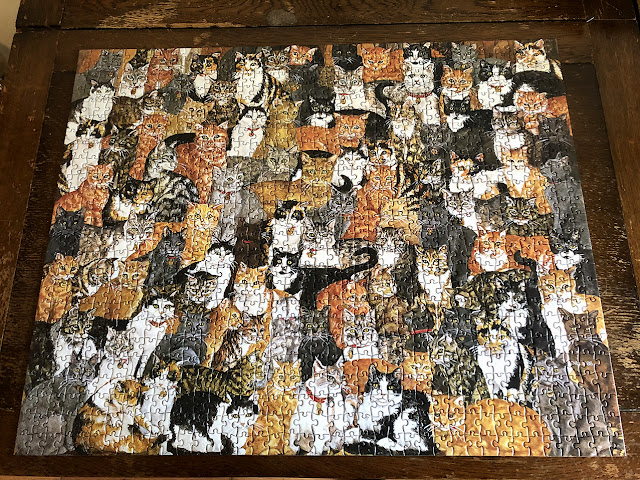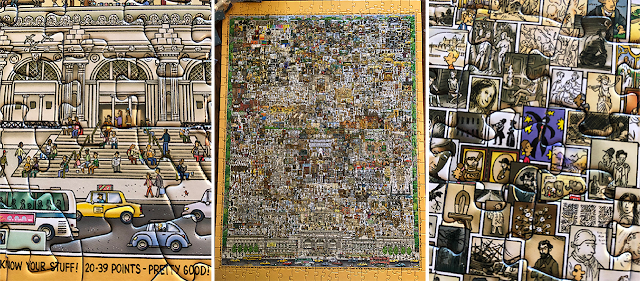The heirloom pumpkins nearly defeated me. They looked so simple, ranked by color across the top of the box. Pretty. Old fashioned. Challenging, but not too challenging. Just the way I like it. And why do I like such challenges? It’s a puzzle.
A literal puzzle, in this case, as well as an interesting question. The pumpkins are the subject of a 1,000-piece jigsaw puzzle I purchased not long ago to feed my puzzling fascination with puzzles.
 |
| I thought I’d never finish this one! (photos by G. S. Norwood. Puzzle by Bas Bleu; uncredited photographer). |
A Deep Family Tradition
I don’t remember when I first started solving puzzles, but the puzzle bug really bit when I was in high school. The family had started spending every Christmas-to-New-Year’s week with my grandparents. We’d come up from Missouri, my aunt would fly in from San Francisco, and we’d entertain ourselves all week by watching football, eating popcorn, and working a giant jigsaw puzzle. One year the puzzle was a close-up photo of popcorn that kept us busy and hungry for days.
Years later, after Warren died and I moved to a house with room to spread out all those puzzle pieces, I decided to revive the Christmas puzzle tradition. That first year I began modestly, with a simple 300-piece puzzle Deb Crombie gave me in tribute to Gift, the cat. In the years since I have collected many, many more. Most of them are 1000-piece puzzles, and many of those are almost as challenging as that popcorn picture.
 |
| The gateway puzzle that got me back into jigsaws. And a few others I’ve solved. (photos by G. S. Norwood. Puzzles: “Rose” (G.’s “gateway”) puzzle by Lang; art by Lowell Herrero. “Unicorn Reading” by Mudpuppy; art by Steph Terao. “Whimsical Village” by artist Anisa Makhoul from eeBoo). |
Chaos and Harmony
One of my main challenges in completing a jigsaw has nothing to do with the puzzle itself, and everything to do with the cat standing on the table amid all those little puzzle pieces. Ella, my beautiful tortie-tabby, is the Queen of Messing with Small Bits of Cardboard. She can bat those suckers under the furniture or into the waiting jaws of a bored dog faster than the eye can follow. Figuring out ways to thwart Ella is a satisfying part of working a jigsaw puzzle.
Gift, my beloved calico, doesn’t really care about messing with my puzzles, but she did save one once. I’d given myself a really beautiful but super-hard 1000-piece puzzle of a marsh owl for Christmas. After many weeks of work I managed to complete it—except for one single missing piece. I knew it had to be on the floor somewhere, probably thanks to Ella.
 |
| Ella (L) loves to mess with my puzzles, but Gift (R) once saved the day. (photos by G. S. Norwood. Puzzle by Bas Bleu; art by Angela Harding). |
I swept, moved furniture, did everything I could to find that piece. No luck. I left the puzzle on the table for months, hoping the piece would turn up. Then, reluctantly, I broke it down and put it back in the box with a little note that one piece was missing.
About a week later, as I was starting a new puzzle, I heard Gift messing around behind me. She was playing cat soccer with the missing piece, batting it all across the hardwood floor. Thank you, sweetie! I’m glad she found it, but I’m not planning to work that puzzle again any time soon.
 |
| Here are a few more puzzles I’ve completed. No missing pieces! (Photos by G. S. Norwood. Puzzles from Quiltfolk. The “Lone Star Quilt” puzzle at right is still available; the other appears to have been discontinued). |
Puzzling Lessons
Why do I enjoy jigsaw puzzles so much? For one thing, they restore my focus on those days when too many issues are grabbing for my attention all at the same time. For another, they are a purely visual pursuit that gives the verbal part of my brain free rein to start cooking up new stories to tell.
 |
| Helping to sharpen the author’s strategic skills! (photos by G. S. Norwood. Puzzles by Bas Bleu: "Kitchen Chickens" at L, and "Songbird Tree." Neither artist credited). |
They can also sharpen my strategic skills. Different puzzles have different anchors from which I can begin the solving process. Are there large areas of one color, like the green stove in Kitchen Chickens, or the brown ground in the Songbird Tree puzzle? I’ll start with those pieces and work my way out.
Although that can backfire. When I sat down to solve the cat puzzle, I decided to start with the cats’ faces, since each of them was different. That meant finding all the pieces that had cats’ eyes on them. Then I had to match the eyes up so I could identify each cat’s face, and figure out where it went in the overall puzzle. The result? Hundreds of cat eyes staring back at me every time I sat down to work.
 |
| All those eyes! (photo by G. S. Norwood. Puzzle “Double Cat Spread” from Pomegranate; artist is Ditz, of Austria). |
Patience, My Friend
Sometimes a hard puzzle can stall out on me. I don’t seem to be making any real progress, and I worry I’ll never get all the pieces into their proper places. That’s when the six-piece rule kicks in. I can usually find one or two pieces when I sit down to work. If I find two, I can often fill in a few more pieces around them. So I have decided that finding six pieces is enough for any single puzzle session. Over the course of a day, I might squeeze in four or five quick sessions. That means I may have 30 new pieces in place by the end of the day.
Eventually those pieces add up, filling in significant areas of the puzzle. And then I’m back on track to solve the whole thing. All it takes is patience and the understanding that six pieces can be plenty.
Of course, I learn other things while I’m working, too. The Metropolitan Museum Map puzzle taught me that I might need reading glasses!
 |
| You need a working knowledge of art history, and really good eyesight (or reading glasses!) to solve this one. (photo by G. S. Norwood. Puzzle by the Met, full puzzle flanked by detail images; uncredited artist). |
It’s a Puzzle
Scientists who study the human brain have begun to look at the effects of solving jigsaw puzzles. They have found that working on a jigsaw puzzle engages both the analytical left side of the brain and the creative right side. Both sides must work together to visualize the puzzle’s pieces and determine where they should go. Such brain activity may help older adults stave off the type of cognitive decline associated with Alzheimer’s disease.
So why aren’t more people out there solving jigsaw puzzles? Well . . . It’s a puzzle!
It’s a Lot More Puzzles (a Gallery)
Editor’s note: G. sent many more photos of wonderful puzzles she has assembled. Here’s a gallery of them. We hope you enjoy them!
 |
| Wentworth “Bookshelf” whimsy wooden puzzle is called a “whimsy” because of the pieces in related shapes. The “Cat Nap” puzzle continues the “book” theme. (Photos by G. S. Norwood. Bookshelf puzzle by Wentworth Wooden Jigsaw Company; art by Colin Thompson. “Cat Nap” puzzle by Eurographics; uncredited artist). |
 |
| Puzzles that feature flowers naturally lead to beautiful results. (Photos by G. S. Norwood. The Sunflower design “Success” puzzle by Lang appears to be discontinued/unavailable. “Flower Catalog” puzzle from the Smithsonian Store; historical images). |
 |
| An appropriately challenging image memorializes the 2017 Women’s March. (Photo by G. S. Norwood. Puzzle by eeBoo; art by Jennifer Orkin Lewis, @AugustWren). |
IMAGES
Photos of assembled puzzles by G. S. Norwood. She offers special thanks to “the sources of so many of my puzzles,” Bas Blue, as well as The Smithsonian Store, and The Metropolitan Museum of Art. Photo montages composed by Jan S. Gephardt.
No comments:
Post a Comment